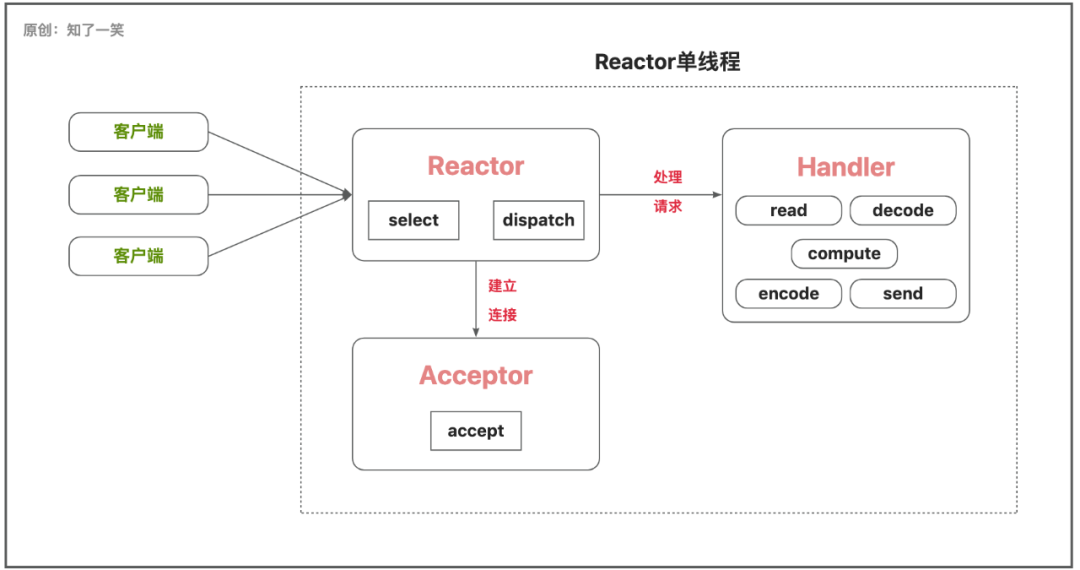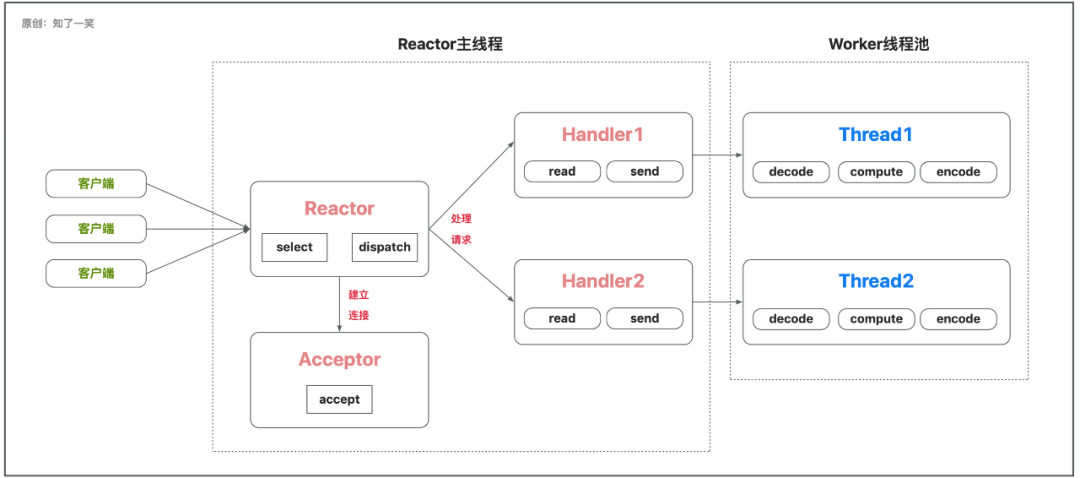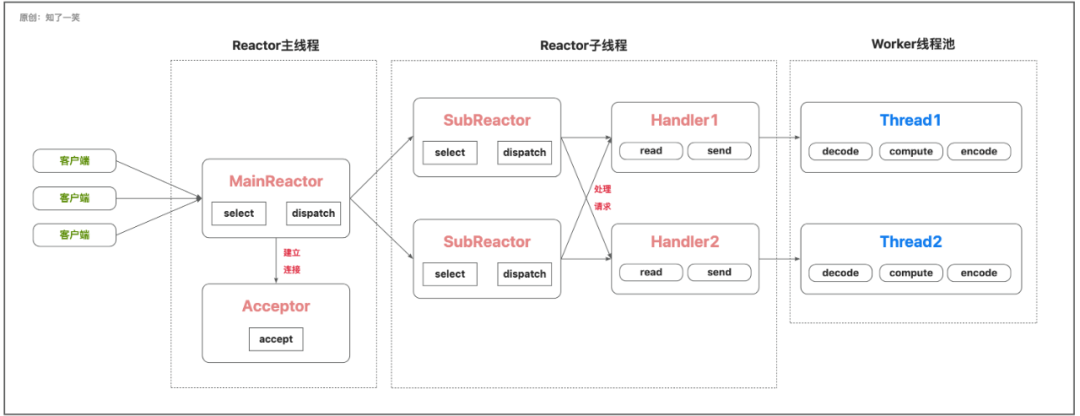一、基礎簡介
在IO流的網絡模型中,以常見的「客戶端-服務端」交互場景為例;

客戶端與服務端進行通信「交互」,可能是同步或者異步,服務端進行「流」處理時,可能是阻塞或者非阻塞模式,當然也有自定義的業務流程需要執行,從處理邏輯看就是「讀取數據-業務執行-應答寫數據」的形式;
Java提供「三種」IO網絡編程模型,即:「BIO同步阻塞」、「NIO同步非阻塞」、「AIO異步非阻塞」;
二、同步阻塞
1、模型圖解
BIO即同步阻塞,服務端收到客戶端的請求時,會啟動一個線程處理,「交互」會阻塞直到整個流程結束;

這種模式如果在高并發且流程復雜耗時的場景下,客戶端的請求響應會存在嚴重的性能問題,并且占用過多資源;
2、參考案例
【服務端】啟動ServerSocket接收客戶端的請求,經過一系列邏輯之后,向客戶端發送消息,注意這里線程的10秒休眠;
public class SocketServer01 {
public static void main(String[] args) throws Exception {
// 1、創建Socket服務端
ServerSocket serverSocket = new ServerSocket(8080);
// 2、方法阻塞等待,直到有客戶端連接
Socket socket = serverSocket.accept();
// 3、輸入流,輸出流
InputStream inStream = socket.getInputStream();
OutputStream outStream = socket.getOutputStream();
// 4、數據接收和響應
int readLen = 0;
byte[] buf = new byte[1024];
if ((readLen=inStream.read(buf)) != -1){
// 接收數據
String readVar = new String(buf, 0, readLen) ;
System.out.println("readVar======="+readVar);
}
// 響應數據
Thread.sleep(10000);
outStream.write("sever-8080-write;".getBytes());
// 5、資源關閉
IoClose.ioClose(outStream,inStream,socket,serverSocket);
}
}【客戶端】Socket連接,先向ServerSocket發送請求,再接收其響應,由于Server端模擬耗時,Client處于長時間阻塞狀態;
public class SocketClient01 {
public static void main(String[] args) throws Exception {
// 1、創建Socket客戶端
Socket socket = new Socket(InetAddress.getLocalHost(), 8080);
// 2、輸入流,輸出流
OutputStream outStream = socket.getOutputStream();
InputStream inStream = socket.getInputStream();
// 3、數據發送和響應接收
// 發送數據
outStream.write("client-hello".getBytes());
// 接收數據
int readLen = 0;
byte[] buf = new byte[1024];
if ((readLen=inStream.read(buf)) != -1){
String readVar = new String(buf, 0, readLen) ;
System.out.println("readVar======="+readVar);
}
// 4、資源關閉
IoClose.ioClose(inStream,outStream,socket);
}
}三、同步非阻塞
1、模型圖解
NIO即同步非阻塞,服務端可以實現一個線程,處理多個客戶端請求連接,服務端的并發能力得到極大的提升;

這種模式下客戶端的請求連接都會注冊到Selector多路復用器上,多路復用器會進行輪詢,對請求連接的IO流進行處理;
2、參考案例
【服務端】單線程可以處理多個客戶端請求,通過輪詢多路復用器查看是否有IO請求;
public class SocketServer01 {
public static void main(String[] args) throws Exception {
try {
//啟動服務開啟監聽
ServerSocketChannel socketChannel = ServerSocketChannel.open();
socketChannel.socket().bind(new InetSocketAddress("127.0.0.1", 8989));
// 設置非阻塞,接受客戶端
socketChannel.configureBlocking(false);
// 打開多路復用器
Selector selector = Selector.open();
// 服務端Socket注冊到多路復用器,指定興趣事件
socketChannel.register(selector, SelectionKey.OP_ACCEPT);
// 多路復用器輪詢
ByteBuffer buffer = ByteBuffer.allocateDirect(1024);
while (selector.select() > 0){
Set<SelectionKey> selectionKeys = selector.selectedKeys();
Iterator<SelectionKey> selectionKeyIter = selectionKeys.iterator();
while (selectionKeyIter.hasNext()){
SelectionKey selectionKey = selectionKeyIter.next() ;
selectionKeyIter.remove();
if(selectionKey.isAcceptable()) {
// 接受新的連接
SocketChannel client = socketChannel.accept();
// 設置讀非阻塞
client.configureBlocking(false);
// 注冊到多路復用器
client.register(selector, SelectionKey.OP_READ);
} else if (selectionKey.isReadable()) {
// 通道可讀
SocketChannel client = (SocketChannel) selectionKey.channel();
int len = client.read(buffer);
if (len > 0){
buffer.flip();
byte[] readArr = new byte[buffer.limit()];
buffer.get(readArr);
System.out.println(client.socket().getPort() + "端口數據:" + new String(readArr));
buffer.clear();
}
}
}
}
} catch (Exception e) {
e.printStackTrace();
}
}
}【客戶端】每隔3秒持續的向通道內寫數據,服務端通過輪詢多路復用器,持續的讀取數據;
public class SocketClient01 {
public static void main(String[] args) throws Exception {
try {
// 連接服務端
SocketChannel socketChannel = SocketChannel.open();
socketChannel.connect(new InetSocketAddress("127.0.0.1", 8989));
ByteBuffer writeBuffer = ByteBuffer.allocate(1024);
String conVar = "client-hello";
writeBuffer.put(conVar.getBytes());
writeBuffer.flip();
// 每隔3S發送一次數據
while (true) {
Thread.sleep(3000);
writeBuffer.rewind();
socketChannel.write(writeBuffer);
writeBuffer.clear();
}
} catch (Exception e) {
e.printStackTrace();
}
}
}四、異步非阻塞
1、模型圖解
AIO即異步非阻塞,對于通道內數據的「讀」和「寫」動作,都是采用異步的模式,對于性能的提升是巨大的;

這與常規的第三方對接模式很相似,本地服務在請求第三方服務時,請求過程耗時很大,會異步執行,第三方第一次回調,確認請求可以被執行;第二次回調則是推送處理結果,這種思想在處理復雜問題時,可以很大程度的提高性能,節省資源:
2、參考案例
【服務端】各種「accept」、「read」、「write」動作是異步,通過Future來獲取計算的結果;
public class SocketServer01 {
public static void main(String[] args) throws Exception {
// 啟動服務開啟監聽
AsynchronousServerSocketChannel socketChannel = AsynchronousServerSocketChannel.open() ;
socketChannel.bind(new InetSocketAddress("127.0.0.1", 8989));
// 指定30秒內獲取客戶端連接,否則超時
Future<AsynchronousSocketChannel> acceptFuture = socketChannel.accept();
AsynchronousSocketChannel asyChannel = acceptFuture.get(30, TimeUnit.SECONDS);
if (asyChannel != null && asyChannel.isOpen()){
// 讀數據
ByteBuffer inBuffer = ByteBuffer.allocate(1024);
Future<Integer> readResult = asyChannel.read(inBuffer);
readResult.get();
System.out.println("read:"+new String(inBuffer.array()));
// 寫數據
inBuffer.flip();
Future<Integer> writeResult = asyChannel.write(ByteBuffer.wrap("server-hello".getBytes()));
writeResult.get();
}
// 關閉資源
asyChannel.close();
}
}【客戶端】相關「connect」、「read」、「write」方法調用是異步的,通過Future來獲取計算的結果;
public class SocketClient01 {
public static void main(String[] args) throws Exception {
// 連接服務端
AsynchronousSocketChannel socketChannel = AsynchronousSocketChannel.open();
Future<Void> result = socketChannel.connect(new InetSocketAddress("127.0.0.1", 8989));
result.get();
// 寫數據
String conVar = "client-hello";
ByteBuffer reqBuffer = ByteBuffer.wrap(conVar.getBytes());
Future<Integer> writeFuture = socketChannel.write(reqBuffer);
writeFuture.get();
// 讀數據
ByteBuffer inBuffer = ByteBuffer.allocate(1024);
Future<Integer> readFuture = socketChannel.read(inBuffer);
readFuture.get();
System.out.println("read:"+new String(inBuffer.array()));
// 關閉資源
socketChannel.close();
}
}五、Reactor模型
1、模型圖解
這部分內容,可以參考「Doug Lea的《IO》」文檔,查看更多細節;
1.1 Reactor設計原理
Reactor模式基于事件驅動設計,也稱為「反應器」模式或者「分發者」模式;服務端收到多個客戶端請求后,會將請求分派給對應的線程處理;

Reactor:負責事件的監聽和分發;Handler:負責處理事件,核心邏輯「read讀」、「decode解碼」、「compute業務計算」、「encode編碼」、「send應答數據」;
1.2 單Reactor單線程

【1】Reactor線程通過select監聽客戶端的請求事件,收到事件后通過Dispatch進行分發;
【2】如果是建立連接請求事件,Acceptor通過「accept」方法獲取連接,并創建一個Handler對象來處理后續業務;
【3】如果不是連接請求事件,則Reactor會將該事件交由當前連接的Handler來處理;
【4】在Handler中,會完成相應的業務流程;
這種模式將所有邏輯「連接、讀寫、業務」放在一個線程中處理,避免多線程的通信,資源競爭等問題,但是存在明顯的并發和性能問題;
1.3 單Reactor多線程

【1】Reactor線程通過select監聽客戶端的請求事件,收到事件后通過Dispatch進行分發;
【2】如果是建立連接請求事件,Acceptor通過「accept」方法獲取連接,并創建一個Handler對象來處理后續業務;
【3】如果不是連接請求事件,則Reactor會將該事件交由當前連接的Handler來處理;
【4】在Handler中,只負責事件響應不處理具體業務,將數據發送給Worker線程池來處理;
【5】Worker線程池會分配具體的線程來處理業務,最后把結果返回給Handler做響應;
這種模式將業務從Reactor單線程分離處理,可以讓其更專注于事件的分發和調度,Handler使用多線程也充分的利用cpu的處理能力,導致邏輯變的更加復雜,Reactor單線程依舊存在高并發的性能問題;
1.4 主從Reactor多線程

【1】 MainReactor主線程通過select監聽客戶端的請求事件,收到事件后通過Dispatch進行分發;
【2】如果是建立連接請求事件,Acceptor通過「accept」方法獲取連接,之后MainReactor將連接分配給SubReactor;
【3】如果不是連接請求事件,則MainReactor將連接分配給SubReactor,SubReactor調用當前連接的Handler來處理;
【4】在Handler中,只負責事件響應不處理具體業務,將數據發送給Worker線程池來處理;
【5】Worker線程池會分配具體的線程來處理業務,最后把結果返回給Handler做響應;
這種模式Reactor線程分工明確,MainReactor負責接收新的請求連接,SubReactor負責后續的交互業務,適應于高并發的處理場景,是Netty組件通信框架的所采用的模式;
2、參考案例
【服務端】提供兩個EventLoopGroup,「ParentGroup」主要是用來接收客戶端的請求連接,真正的處理是轉交給「ChildGroup」執行,即Reactor多線程模型;
@Slf4j
public class NettyServer {
public static void main(String[] args) {
// EventLoop組,處理事件和IO
EventLoopGroup parentGroup = new NioEventLoopGroup();
EventLoopGroup childGroup = new NioEventLoopGroup();
try {
// 服務端啟動引導類
ServerBootstrap serverBootstrap = new ServerBootstrap();
serverBootstrap.group(parentGroup, childGroup)
.channel(NioServerSocketChannel.class).childHandler(new ServerChannelInit());
// 異步IO的結果
ChannelFuture channelFuture = serverBootstrap.bind(8989).sync();
channelFuture.channel().closeFuture().sync();
} catch (Exception e){
e.printStackTrace();
} finally {
parentGroup.shutdownGracefully();
childGroup.shutdownGracefully();
}
}
}
class ServerChannelInit extends ChannelInitializer<SocketChannel> {
@Override
protected void initChannel(SocketChannel socketChannel) {
// 獲取管道
ChannelPipeline pipeline = socketChannel.pipeline();
// 編碼、解碼器
pipeline.addLast(new StringDecoder(CharsetUtil.UTF_8));
pipeline.addLast(new StringEncoder(CharsetUtil.UTF_8));
// 添加自定義的handler
pipeline.addLast("serverHandler", new ServerHandler());
}
}
class ServerHandler extends ChannelInboundHandlerAdapter {
/**
* 通道讀和寫
*/
@Override
public void channelRead(ChannelHandlerContext ctx, Object msg) throws Exception {
System.out.println("Server-Msg【"+msg+"】");
TimeUnit.MILLISECONDS.sleep(2000);
String nowTime = DateTime.now().toString(DatePattern.NORM_DATETIME_PATTERN) ;
ctx.channel().writeAndFlush("hello-client;time:" + nowTime);
ctx.fireChannelActive();
}
@Override
public void exceptionCaught(ChannelHandlerContext ctx,Throwable cause) throws Exception {
cause.printStackTrace();
ctx.close();
}
}
【客戶端】通過Bootstrap類,與服務器建立連接,服務端通過ServerBootstrap啟動服務,綁定在8989端口,然后服務端和客戶端進行通信;
public class NettyClient {
public static void main(String[] args) {
// EventLoop處理事件和IO
NioEventLoopGroup eventLoopGroup = new NioEventLoopGroup();
try {
// 客戶端通道引導
Bootstrap bootstrap = new Bootstrap();
bootstrap.group(eventLoopGroup)
.channel(NioSocketChannel.class).handler(new ClientChannelInit());
// 異步IO的結果
ChannelFuture channelFuture = bootstrap.connect("localhost", 8989).sync();
channelFuture.channel().closeFuture().sync();
} catch (Exception e){
e.printStackTrace();
} finally {
eventLoopGroup.shutdownGracefully();
}
}
}
class ClientChannelInit extends ChannelInitializer<SocketChannel> {
@Override
protected void initChannel(SocketChannel socketChannel) {
// 獲取管道
ChannelPipeline pipeline = socketChannel.pipeline();
// 編碼、解碼器
pipeline.addLast(new StringDecoder(CharsetUtil.UTF_8));
pipeline.addLast(new StringEncoder(CharsetUtil.UTF_8));
// 添加自定義的handler
pipeline.addLast("clientHandler", new ClientHandler());
}
}
class ClientHandler extends ChannelInboundHandlerAdapter {
/**
* 通道讀和寫
*/
@Override
public void channelRead(ChannelHandlerContext ctx, Object msg) throws Exception {
System.out.println("Client-Msg【"+msg+"】");
TimeUnit.MILLISECONDS.sleep(2000);
String nowTime = DateTime.now().toString(DatePattern.NORM_DATETIME_PATTERN) ;
ctx.channel().writeAndFlush("hello-server;time:" + nowTime);
}
@Override
public void channelActive(ChannelHandlerContext ctx) throws Exception {
ctx.channel().writeAndFlush("channel...active");
}
@Override
public void exceptionCaught(ChannelHandlerContext ctx,Throwable cause) throws Exception {
cause.printStackTrace();
ctx.close();
}
}六、參考源碼
編程文檔:
https://gitee.com/cicadasmile/butte-java-note
應用倉庫:
https://gitee.com/cicadasmile/butte-flyer-parent















































